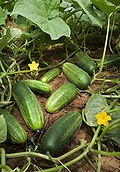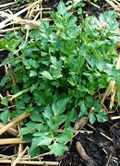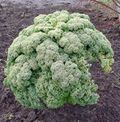Difference between revisions of "Daily Gardening Tips"
From eagle-rock.org
| Line 7: | Line 7: | ||
!style="background:YellowGreen" | Day !!style="background:YellowGreen" |Topic !!style="background:YellowGreen" |Tip !!style="background:YellowGreen" |Photo !!style="background:YellowGreen" |Photo caption !!style="background:YellowGreen" |More | !style="background:YellowGreen" | Day !!style="background:YellowGreen" |Topic !!style="background:YellowGreen" |Tip !!style="background:YellowGreen" |Photo !!style="background:YellowGreen" |Photo caption !!style="background:YellowGreen" |More | ||
|- | |- | ||
| − | |style="background:LightYellow" | 22 ||style="background:LightYellow" |Seed saving||style="background:LightYellow" |One of the biggest problems that is facing gardeners, farmers and eventually all humans is the rapid loss of old seed varieties. More and more what's being sold and available are hybrid and genetically modified seeds. Many local farmers and indigenous tribes have traditionally relied on special species of vegetables and staple crops that were suitable for their land and weather circumstances and for which healthy local food recipes were developed. Some organizations try to reverse this negative trend.||style="background:LightYellow" |[[File:Peruvian corn.jpg|120px|]] ||style="background:LightYellow" | | + | |style="background:LightYellow" | 22 ||style="background:LightYellow" |Seed saving||style="background:LightYellow" |One of the biggest problems that is facing gardeners, farmers and eventually all humans is the rapid loss of old seed varieties. More and more what's being sold and available are hybrid and genetically modified seeds. Many local farmers and indigenous tribes have traditionally relied on special species of vegetables and staple crops that were suitable for their land and weather circumstances and for which healthy local food recipes were developed. Some organizations try to reverse this negative trend.||style="background:LightYellow" |[[File:Peruvian corn.jpg|120px|]] ||style="background:LightYellow" |Corn varieties in Peru ||style="background:LightYellow" |[[Seed cultivation and saving]] |
|- | |- | ||
|style="background:LightYellow" | 21 ||style="background:LightYellow" |Alchemilla||style="background:LightYellow" |Alchemilla or Lady's Mantle is a perennial plant that flowers in late spring and summer. It is found both in the wild and in cultivated gardens. It especially grows in the colder regions of the north beyond the arctic circle and only on high mountain ranges such as the Himalayas in southern latitudes. The whole herb can be gathered and dried in June and July when in flower and when the leaves are at their best. It is applied in the form of teas and extracts. The root is sometimes also employed, generally fresh. No side-effects are noted. It is traditionally used as a woman's healing herb.||style="background:LightYellow" |[[File:Lady%27s_mantle_120619_%284%29.JPG|120px|]] ||style="background:LightYellow" |Alchemilla in my garden in June ||style="background:LightYellow" |[[Alchemilla]] | |style="background:LightYellow" | 21 ||style="background:LightYellow" |Alchemilla||style="background:LightYellow" |Alchemilla or Lady's Mantle is a perennial plant that flowers in late spring and summer. It is found both in the wild and in cultivated gardens. It especially grows in the colder regions of the north beyond the arctic circle and only on high mountain ranges such as the Himalayas in southern latitudes. The whole herb can be gathered and dried in June and July when in flower and when the leaves are at their best. It is applied in the form of teas and extracts. The root is sometimes also employed, generally fresh. No side-effects are noted. It is traditionally used as a woman's healing herb.||style="background:LightYellow" |[[File:Lady%27s_mantle_120619_%284%29.JPG|120px|]] ||style="background:LightYellow" |Alchemilla in my garden in June ||style="background:LightYellow" |[[Alchemilla]] | ||
Revision as of 04:28, 22 June 2012
- All these tips and more first appeared on this Facebook page.
- List of Daily Gardening Tips gives an alphabetical list of all tips.
June 2012
Day Topic Tip Photo Photo caption More 22 Seed saving One of the biggest problems that is facing gardeners, farmers and eventually all humans is the rapid loss of old seed varieties. More and more what's being sold and available are hybrid and genetically modified seeds. Many local farmers and indigenous tribes have traditionally relied on special species of vegetables and staple crops that were suitable for their land and weather circumstances and for which healthy local food recipes were developed. Some organizations try to reverse this negative trend. 
Corn varieties in Peru Seed cultivation and saving 21 Alchemilla Alchemilla or Lady's Mantle is a perennial plant that flowers in late spring and summer. It is found both in the wild and in cultivated gardens. It especially grows in the colder regions of the north beyond the arctic circle and only on high mountain ranges such as the Himalayas in southern latitudes. The whole herb can be gathered and dried in June and July when in flower and when the leaves are at their best. It is applied in the form of teas and extracts. The root is sometimes also employed, generally fresh. No side-effects are noted. It is traditionally used as a woman's healing herb. Alchemilla in my garden in June Alchemilla 20 Leek Fertilize your soil well with compost. Sow summer leek plants from January to April inside in a shallow box or in a row in greenhouse or in a cold frame. Sow winter leek from March to the first half of May in the same way. You can also sow directly in the soil, this gives you less trouble with the leek fly. Transplant when the plants are as thick as a pencil. Make trenches of 20 cm deep and plant leek in these trenches. You can also plant in holes made with the backside of the stick of one of your garden tools. You can hill up the plants as they grow but prevent soil from coming between the leaves. Summer leek plants in June Leek 19 In harmony with your garden A garden is the natural environment in which you live. As you take care of your garden, it will partly form because of your actions, but the power of nature will always remain. That power of nature is healing and harmonizing. Nature always brings itself back into balance after a disturbance or change. When you and your garden come in harmony, this also will apply to yourself. It means that your garden will continually adapt and recreate itself to give you all the health you need. Sometimes this can be amazing, that when you or someone in your family attracts a disease, the medicinal plants that can heal you will suddenly appear in your garden. Of course, this can only happen when you treat your garden as a part of nature and don't destroy it with unnatural chemicals or other products. Also, you must have eye for the 'own will' of a garden. Weeds can be problematic, but not always, because some of them may be the healing agents that nature sends you. 
Forest Garden Spiritual aspects of gardening 18 Kale Kale was one of the most common vegetables in Europe already before the Middle Ages. Some varieties existed in ancient Greece. Kale is an easy crop to cultivate and grows on most every soil. Sow preferably in April, not later than the end of June. You can sow in a row, or in pots, and plant out later. Kale can tolerate shade quite well. You can plant them between crops that are going to be harvested in the summer. By the time that the kale plants get bigger, the other crops will be gone. Kale 17 Gardening in the Garden of Eden The Book of Genesis said that Adam and Eve were cast out from the Garden of Eden after their fall. What does this actually mean? It means that Adam and Eve had lost their awareness of what this beautiful Garden of Eden means. They did not understand anymore that this Garden was for them to develop their love and creativity, that this Garden could teach them how to care and that through this Garden they could relate not only to the world of plants and animals, but also to the entire spirit world of spiritual beings created by God. 
Thomas Cole: The Garden of Eden Gardening in the Garden of Eden 16 Bees in new hive A few days ago one of our bee colonies swarmed out. They gathered in the top of a huge Thuja tree, but eventually we got them out and made a new hive for them. You can see the hive in the other photos of this album. This type of bee hive is simply a box with laths of 5 cm as cover. We fed the bees with honey and some sugar water. For three days they had to get used to their new home. Some of the bees had died and the other bees were busy throwing these dead ones out. Yesterday they began flying out again and in one day they built two of these beautiful new combs, fixed to two of the laths. On the photo you see one of the combs. Bees in new hive making a comb Bee 15 Gherkins Gherkins and commercial cucumbers belong to the same species (Cucumis sativus), but are from different cultivar groups. You sow gherkins in May and June. Sow in a cold frame, in pots or in a greenhouse, or outside from the end of May. Sow 3 seeds together and keep the strongest. Gherkins needs full sun and a humus-rich fertile soil. Plant distance: 40 cm in the row, 90 cm between the rows. 
From Deutschlands Flora in Abbildungen Gherkin 14 Mycorrhiza 'Mycorrhiza' is a new page on the Eagle Rock Wiki site. This is about how fungi help plants to take in many nutrients from the soil. It's only more recently that scientists and farmers became aware of the importance of mycorrhizae. The underground mycelium of fungi, for example ordinary mushrooms, extend the root systems of plants. They can even connect several trees together and these trees, through their 'internet' communicate with each other, help each other in times of drought and scarcity. 
The photo shows a network of hyphae of a fungi that inhabits the roots of flax Mycorrhiza 13 Fava beans Sow fava beans (also called broad beans) in February and March. You can also sow under glass already in late autumn or January. Fava beans can overwinter. Don't add manure to the soil but some old compost is ok, or sawdust to prevent the beans from rotting. Sow some dill in the same row, they protect against blackfly. Another method against blackfly is to pinch out the tops when the plant begins to blossom. You can stir-fry these tops and they are delicious. 
Fava bean 12 Endive Endive is a member of the chicory genus, of which the leaves are often bitter. You can sow them in March under glass and plant them out in May, or sow outside after June 21 for winter harvest. During the first month of growth, endive should not be exposed to temperatures below 50 F (10 C) or the plants will soon make flowers instead of nice green heads. Seeds sown after June 21 won't make flowers anymore. 
Foto source Endive 11 Cucumber The cucumber originates in India but is now grown around the world. Depending on the cultivar you can grow them in a greenhouse, a cold frame or outside. In April you can sow inside, in May until June 21 also outside. Cucumbers like humus-rich soil and ample compost. A temperature of 70 F (21 C) when the plant grows up gives stronger plants and better results. Most varieties have seeds. Male and female flowers grow at the same plant and pollination is required. 
Cucumber 10 Celery The normal celery, of which the leaves are used, is sown in spring in March and later again in September. I usually sow in pots and plant them out later. You can also mix the seeds with moist sand and let them start to germinate before sowing outside. In September you can sow in pots or under glass. You can actually sow through the entire summer, but the plants won't become as big as those sown in March. 
Celery 9 Growing carrots Carrots like any soil but rocks will deform them. They also don't like and don't need compost or manure. I always sow them in a field that was composted the year before and where another crop has grown on that compost. They grow well even in soils that are so poor that most other crops won't develop. Sow summer carrots from February to the end of June. Winter carrots from March to May. Add wet sand to the seeds and keep them a few days like this, then sow the seeds together with the sand. The sand helps you sow regularly and the moist seeds germinate faster. Sow ca 2 cm deep. 
From Deutschlands Flora in Abbildungen Carrot 8 Beetroot You can sow beetroot directly into the soil. It helps to put the seeds a few days in water to make them germinate faster. You can also sow beets in pots and then plant them out, but because beets have taproots you cannot keep them long in pots. Thin the beets at 15 cm in the row. Desired pH = 6-6.5 (a bit acid). Beetroots need to grow in the full sun and don't tolerate shade. Beetroot Beetroot 7 Growing beans Only sow when there's no danger anymore for frost or night frost. For the region where i have my garden (temperate climate, northern hemisphere) this is after May 15. You can sow until half July, depending on the species. Don't add fresh manure to the soil, but beans like a humus-rich soil so you can add some old compost or saw dust to prevent the beans from rotting. Beans like full sun and dislike cold and wet weather. 
Green beans Bean (Phaseolus vulgaris) 6 Watering plants When you water your lawn or your plants, outside or in a greenhouse, it's better to do this infrequently than to sprinkle daily. When you give water daily the plants have the tendency to keep their roots near the surface. But when you occasionally give them a good quantity of water, the plants will send their roots deeper and the entire plants become stronger. 
Sprinkler Watering a garden 5 Integrated garden What is an integrated garden? It is a garden with a variety of different plants, medicinal plants, herbs, flowers, leaf vegetables, root vegetables, berry bushes, etc. Each plant species has its own energy and also receives typical energies from the cosmos and the earth and all that is around. Flowers receive other energies than roots. Plants can mutually enrich one another in the sense of energies. Crops grown in such a garden have better nurturing elements for your spiritual well-being. Sweet William & foxglove, garlic, cabbage, potatoes Spiritual aspects of gardening 4 Preparing the soil Section 4 of the Gardening Seminar:Start your own garden tells about different soil layers, digging a soil and water management. Normal digging with a spade Preparing the soil 3 Mulching In nature healthy soils are covered, either with green plants or with leaf litter. Covered soil has a crumbly texture, allows water to pass through and is a rich environment for many micro-organisms that need oxygen. Soil under a layer of mulch will seldom dry out. In our garden we can copy this natural condition by sowing green manure plants on empty fields, or covering them with a layer of mulch. For mulch we can use hay or straw or also any other natural material. You can also cover the soil with mulch in-between bigger plants, such as berry bushes and larger perennials. 
Leaves make natural mulch Mulching 2 Bees in the garden "Bees play an important role in pollinating flowering plants, and are the major type of pollinator in ecosystems that contain flowering plants. Bees either focus on gathering nectar or on gathering pollen depending on demand, especially in social species. Bees gathering nectar may accomplish pollination, but bees that are deliberately gathering pollen are more efficient pollinators. It is estimated that one third of the human food supply depends on insect pollination, most of which is accomplished by bees, especially the domesticated European honey bee."[1] A swarm of bees Pollination 1 Sowing "Prepare the surface earth well, to make a good seed-bed. Plant when the ground is moist, if possible, and preferably just before a rain... For shallow-planted seeds, firm the earth above them by walking over the row or by patting it down with a hoe [I usually do it with the back side of a rake, or with my hand]. Special care should be exercised not to sow very small and slow-germinating seeds, as celery, carrot, onion, in poorly prepared soil or in ground that bakes. The photo shows little holes made with a board with bumps for sowing radish seeds. I cover them with lava gravel or fine soil. Sowing









